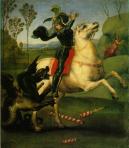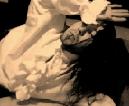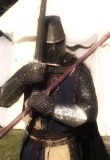 |
|
|
|
| Author |
Message |
Colin

Location: Wellington
|
 Posted: Sat Jan 06, 2007 11:59 am Misconceptions over the quarterstaff Posted: Sat Jan 06, 2007 11:59 am Misconceptions over the quarterstaff |
 |
|
Rather than derail this thread on a club's tournament
( http://gatheringdarkness.co.nz/forum/viewtopic.php?t=199 ) I've decided to start a new thread here 
| Bogue wrote: | | Technically they are IPW (improvised peasant weapons) and would not have been swung by someone of lordly mien in a tournament situation. |
In England they were a walking stick. One end is tipped so it can be used to grip the ground. George Silver was a gentlemen, i.e., part of the aristocracy, which precludes him from being a peasant.
Over in the continent, Joachim Meyer, wrote a book on knightly fencing. It included how to fight with staves.
Staves are not "improvised peasant weapons". They may not be part of the usual knightly tournaments, part they're a far cry from being something only a peasant improvises.
| Patch wrote: | | As an example of what we really need to avoid here, making a standard quarterstaff strike to a fully plated knee tends to make a light bonking noise and even if you were furiously pounding away for 5 minutes at the plated pieces, you are probably going to knock the poor fellow off his feet before you damage the tender flesh underneath. And you don’t want to award “killing blow” credit to the stave wielder under those conditions. |
Maybe using the stage combat acting techniques this could be true. Using techniques espoused by George Silver, Joseph Swetnam, or Zachary Wylde this is complete nonsense. While they don't recommend knee shots anyway (legs usually being a stupid target that the ignorant use), the techniques used would make short work of anybody in any form of armour I'm currently aware of (modern or historic).
Assault with staff is my biggest dilemna. I've been forced to put it on the back burner simply because I have no idea how to make assaulting with oak or ash staves safe. The Stoccata School of Defence has a multi-prong approach to staff fighting. For the really physical and energetic assaults they use bamboo with tennis balls attached to both ends. The life span of bamboo isn't great, and I don't have a ready supply of the stuff  |
|
|
 |
NigelT
Site Admin

Location: Wellington
|
 Posted: Sun Jan 07, 2007 9:02 pm Posted: Sun Jan 07, 2007 9:02 pm |
 |
|
Colin, you've mentioned that a staff probably wouldn't have been carried by a noble into battle, but that doesn't preclude regular infantry. There are certainly divided opinions in the NAAMA world about whether a staff would be of any use in a mass assault due to it's space requirement for anything other than an overhead strike or thrust.
Do you have any thoughts on whether it would have been used and if so how it might have been employed effectively?
Nigel |
|
|
 |
Colin

Location: Wellington
|
 Posted: Mon Jan 08, 2007 6:39 am Posted: Mon Jan 08, 2007 6:39 am |
 |
|
| NigelT wrote: | Colin, you've mentioned that a staff probably wouldn't have been carried by a noble into battle, but that doesn't preclude regular infantry. There are certainly divided opinions in the NAAMA world about whether a staff would be of any use in a mass assault due to it's space requirement for anything other than an overhead strike or thrust.
Do you have any thoughts on whether it would have been used and if so how it might have been employed effectively?
Nigel |
Paradox 21, from Paradoxes of Defence
"Yet understand, that in battles, and where variety of weapons are, among multitudes of men and horses, the sword and target, the two handed sword, battle axe, the black bill, and halberd, are better weapons, and more dangerous in their offense and forces, than is the sword and buckler, short staff, long staff, or forest bill. The sword and target leads upon shot, and in troops defends thrusts and blows given by battle axe, halberds, black bill, or two handed swords, far better than can the sword and buckler.
"The morris pike defends the battle from both horse and man, much better than can the short staff, long staff, or forest bill. Again the battle axe, the halberd, the black bill, the two handed sword, and sword & target, among armed men and troops, by reason of their weights, shortness, and great force, do much more offend the enemy, & are then much better weapons, than is the short staff, the long staff, or the forest bill."
IOW staves according to George Silver staves aren't great battle weapons.
As for staves themselves: a common and cheap weapon for infantry was to grab a longish piece of ash, whittle down one end, and put that end in fire. In other words the staff becomes a fire hardened spear. Of course they could get iron axe, spear, pike, halberd, glaive, or bill heads made by the artisans (smiths) who accompanied the armies. Not exactly rocket science.
I'm answering this from an historical perspective. Men were drawn up in units and fought in their respective units in typically tight formations (they tended to die otherwise). What re-enactors get upto with whatever it is they do, is up to them. |
|
|
 |
Víkarr
|
 Posted: Tue Jan 09, 2007 10:40 am Posted: Tue Jan 09, 2007 10:40 am |
 |
|
| Swordsmanship wrote: | | As for staves themselves: a common and cheap weapon for infantry was to grab a longish piece of ash, whittle down one end, and put that end in fire. In other words the staff becomes a fire hardened spear. |
Hi Colin. Just curious, could you tell me who specifically used this type of weapon - which infantry are we talking here? I'd be very interested to know some of the history of this sort of weapon.
Cheers,
V. |
|
|
 |
Colin

Location: Wellington
|
 Posted: Tue Jan 09, 2007 11:20 am Posted: Tue Jan 09, 2007 11:20 am |
 |
|
It was incorrect of me to state "common". Supposedly in the cross over of the late antiquities and dark ages the Germanic tribes were "so primitive" and poor in their equipment that the common warrior didn't have armour and used fire hardened spears.
Something I disagree with, but I'm sure I can dig out a quote of such from a book I have on the Battle of Adrianople.
My reply was derision at the common belief that peasants in the Dark and Middle Ages were dirt poor. It just didn't come out that way 
(Fire hardened tools were common, apparently, prior to flint tools) |
|
|
 |
Colin

Location: Wellington
|
 Posted: Tue Jan 16, 2007 12:59 pm Posted: Tue Jan 16, 2007 12:59 pm |
 |
|
| fuzzy wrote: | | I know when I use quarterstave against guys in plate it is bloody hard to get a killer hit in, and am sure our medieval counterparts 600 years ago would have had the same problems. |
I can refer you to a Wellingtonian by the name of Nick Smith. When I could still be bothered with re-enactment in 2003 (?) at the Levin NAAMA camp. Nick wanted me to hit him.
Nick Smith wearing his War of the Roses replica armour (ie. plate) wanted me to hit him with my oak quarterstaff. I refused. After much pleading I eventually relented as said I'd hit with the staff if he could successfully block me hitting him with a bastard sword.
I told him exactly where I was going to hit. I even showed him exactly where I was going to strike from, and the exact cut. Nick got his sword and dagger, and actively used the "guard" that's supposed to stop two handed swords (remembering he's also wearing plate). You know that stupid cross BS.
Do you think the guard worked?
If you said yes, you have no idea about physics.
I hit Nick in a single line in four places through the useless guard. One at his gauntlet where the strong of the sword crushed it. The other three were on his helmet. He had his visor up. I split the rolled steel top and bottom of his visor. At the very top of his sallet where the ridge is, I shaved the steel on his helmet. Four places. If you some how doubt the validity, when you're next in Wellington ask Nick to show you the helmet that I did it too (I believe he's repaired his gauntlets).
This was with a blunt sword BTW.
Did Nick want me to hit him again with the bastard sword? No. Howabout a two handed sword? No. And finally the quarterstaff? The answer was no to all three. In fact he said at the time "I've been humbled".
Was Nick still nuts? Yes. He went and acted as a pell while the Order of the Boar broke lances on him (you know the stuff from horse back.) Nick would rather be struck by people charging at him with lances than get hit with a staff...even knowing exactly where the staff was going to hit.
What rules you come up with for whatever you do, fine. Just don't try and make it out to be historical "reality". It isn't. Staves will make short work of people in armour. As I said earlier, staff assaulting remains my biggest challenge to pull off safely. |
|
|
 |
Gerard Kraay
|
 Posted: Fri Jan 19, 2007 12:38 pm Posted: Fri Jan 19, 2007 12:38 pm |
 |
|
[quote="Swordsmanship"] | fuzzy wrote: | | I know when I use quarterstave against guys in plate it is bloody hard to get a killer hit in, and am sure our medieval counterparts 600 years ago would have had the same problems. |
I just can't understand how people can have these ridiculous opinions when there is so much evidence; primary source including, that refutes them. Some more study and real WMA practice would clear these inaccuracies up, but no, for many it's just a game.
_________________
"The Dragon made me do it." |
|
|
 |
adrianf

Location: palmerston north
|
 Posted: Thu Mar 29, 2007 11:39 am Posted: Thu Mar 29, 2007 11:39 am |
 |
|
[quote="blackcrow"] | Swordsmanship wrote: | | fuzzy wrote: | | I know when I use quarterstave against guys in plate it is bloody hard to get a killer hit in, and am sure our medieval counterparts 600 years ago would have had the same problems. |
I just can't understand how people can have these ridiculous opinions when there is so much evidence; primary source including, that refutes them. Some more study and real WMA practice would clear these inaccuracies up, but no, for many it's just a game. |
I see a lot of misconceptions about staffs because often the only staff they see are the short poles we use for NAAMA type combat, which are related to true staffs in the same way a letter opener is related to a sword |
|
|
 |
Colin

Location: Wellington
|
 Posted: Thu Mar 29, 2007 4:50 pm Posted: Thu Mar 29, 2007 4:50 pm |
 |
|
| adrianf wrote: |
I see a lot of misconceptions about staffs because often the only staff they see are the short poles we use for NAAMA type combat, which are related to true staffs in the same way a letter opener is related to a sword |
Yes, I not entirely sure where the old fight directors picked up their inspiration for 'quarterstaff'. It certainly wasn't from Victorian England which used similar length staves as George Silver recommended (eight to nine feet in length). Inspiration of it may have come from France by way of grand baton in the savate set of weapons. Originally grand baton was to teach bayonet fencing to (French) soldiers, but like a lot of other things came into its own system. Maybe they just needed something that wasn't so destructive to their stage props. A short thin stick might have been perfect.
_________________
The person who writes for fools is always sure of a large audience.
- Arthur Schopenhauer
See http://www.swordsmanship.co.nz/ |
|
|
 |
Vorschlag

Location: Auckland
|
 Posted: Sat Mar 31, 2007 1:01 am Posted: Sat Mar 31, 2007 1:01 am |
 |
|
Well if people want to see what a real quarterstaff looks like and understand why they were and will be effective against someone in or out of armour in single combat they could always come along on Sunday for a look.
http://swordsmanship.co.nz/asema/index.html
_________________
On five words hinge the entire art of the sword, in and out of armour, on horse and on foot. |
|
|
 |
Patch

Location: Auckland
|
 Posted: Sun Apr 01, 2007 3:29 am Posted: Sun Apr 01, 2007 3:29 am |
 |
|
| Quote: | As an example of what we really need to avoid here, making a standard quarterstaff strike to a fully plated knee tends to make a light bonking noise and even if you were furiously pounding away for 5 minutes at the plated pieces, you are probably going to knock the poor fellow off his feet before you damage the tender flesh underneath. And you don’t want to award “killing blow” credit to the stave wielder under those conditions.
Maybe using the stage combat acting techniques this could be true. Using techniques espoused by George Silver, Joseph Swetnam, or Zachary Wylde this is complete nonsense. While they don't recommend knee shots anyway (legs usually being a stupid target that the ignorant use), the techniques used would make short work of anybody in any form of armour I'm currently aware of (modern or historic). |
Might I respectfully suggest that this quote was drawn rather out of context. In fact if you read through the origin topic I was specifically talking about relatively light shafts used in an improvised fashion, such as a weak strike of opportunity with the butt of an axe. Equally clearly at the time I suggested that if you take a great oaken cudgel with an impact potential equal or greater than a war hammer, and combine that with the kinds of techniques you are talking about here, then of course it would be considered a sufficient hit, even in the context of the original discussion about a simplified ruleset pertinent to an armored dueling environment, the key note of which was that it was the marshals adjudication of the strike which made a score in the system and that these rules were but a guideline.
I am in accord with your opinion on this one. |
|
|
 |
|
|
 Please read the terms of use
Please read the terms of use
 Contact the Site Admin
Contact the Site Admin

